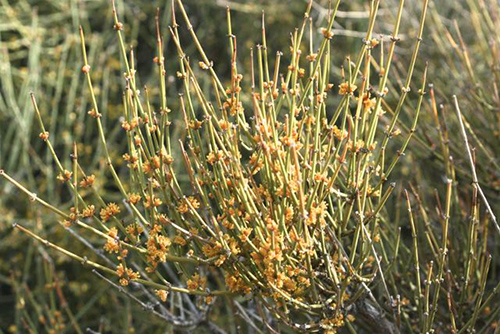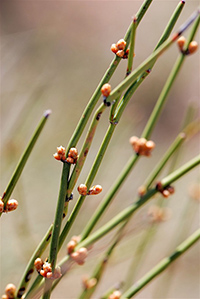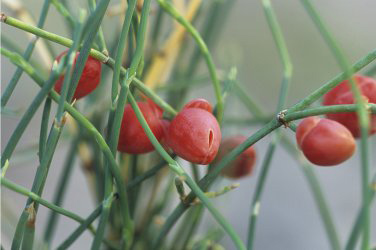Contents
The Mormon tea plant may be the medicinal herb used for the longest time. It was first known in China, where it was called mahuang, and the Chinese had used it for several thousand years. Western medicine did not discover this plant until the 19th century. In 1926, its active principle, ephedrine, was first synthesized by Merk Laboratories in Germany. Since then, it has become part of several medicines.

Healing Properties and Warning
The whole plant contains ephedrine, an active alkaloid that acts on the nervous system, tannin, saponin, flavons, and an essential oil. Ephedrine acts in a way similar to adrenaline, stimulating the sympathetic nervous system (sympathomimetic action). It increases blood pressure, produces tachycardia, relaxes the bronchial muscles, increases perspiration and gastric and salivary secretions, and provokes mydriasis (dilation of pupils).
Its most crucial medical use is for bronchial asthma due to its bronchodilator effect and allergic reactions (nettle rash, hay fever, etc.) since it neutralizes allergy symptoms.
WARNING! It is a toxic but not deadly plant. Only medical professionals can correctly prescribe this plant due to its complex actions on the human body.

Mormon Tea Plant Scientific Facts

- Other names: Bringham Young weed, desert herb, ephedra, desert tea, squaw tea, teamster’s tea.
- French: Ephedre.
- Spanish: Efedra, uva de mar.
- Environment: Dry, arid, rocky soils on the coastline and in the hinterland. Native to Central Asia, nowadays, it has been naturalized in dry areas of Europe and America.
- Description: Vivacious shrub of the Ephedraceae family, growing up to 25 cm high, with fine branches whose knots grow yellow flowers. The fruit has a red wine color.
- Parts of the plant used medicinally: The stems and branches.
How to use Mormon Tea
- Pharmaceutical preparations: drops, pills, suppositories.
DISCLAIMER: All content on this website is presented solely for educational and informational objectives. Do not rely on the information provided as a replacement for advice, diagnosis, or treatment from a qualified medical expert. If you are pregnant, nursing, or have any preexisting medical concerns, talk to your doctor before using any herbal or natural medicines.
REFERENCES
- George D. Pamplona-Roger, M.D. “Encyclopedia of Medicinal Plants.” George D. Pamplona-Roger, M.D. Encyclopedia of Medicinal Plants. Ed. Francesc X. Gelabert. Vols. 1 San Fernando de Henares: Editorial Safeliz, 2000. 303. Print.[mormon tea]
- WebMD: https://www.webmd.com/vitamins/ai/ingredientmono-569/mormon-tea
- RxList: https://www.rxlist.com/supplements/mormon_tea.htm
- Plants for a Future (PFAF): https://pfaf.org/User/Plant.aspx?LatinName=Ephedra+viridis
- Native American Ethnobotany Database (University of Michigan-Dearborn): http://naeb.brit.org/
